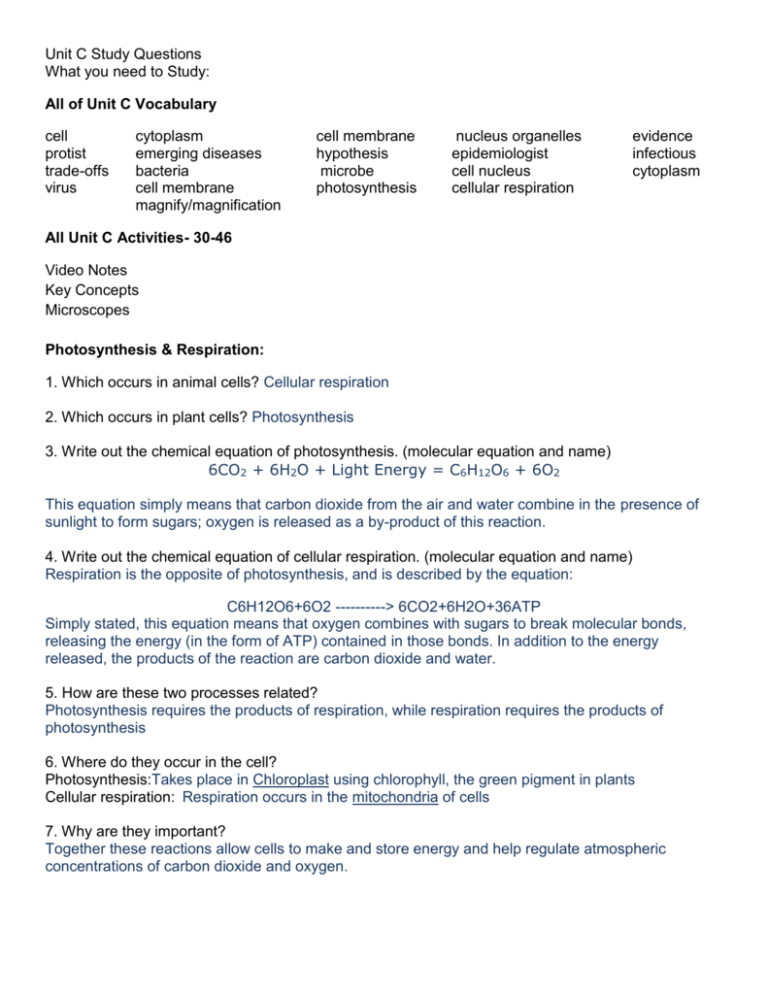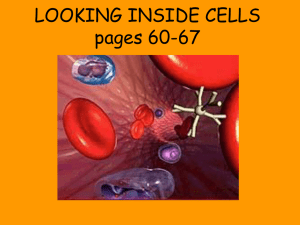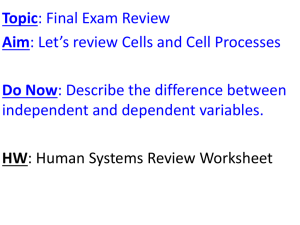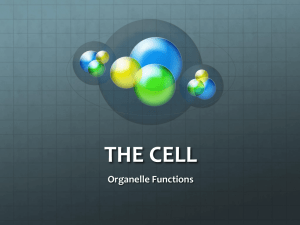Unit C Study Questions_Answers - AMA
advertisement

Unit C Study Questions What you need to Study: All of Unit C Vocabulary cell protist trade-offs virus cytoplasm emerging diseases bacteria cell membrane magnify/magnification cell membrane hypothesis microbe photosynthesis nucleus organelles epidemiologist cell nucleus cellular respiration evidence infectious cytoplasm All Unit C Activities- 30-46 Video Notes Key Concepts Microscopes Photosynthesis & Respiration: 1. Which occurs in animal cells? Cellular respiration 2. Which occurs in plant cells? Photosynthesis 3. Write out the chemical equation of photosynthesis. (molecular equation and name) 6CO2 + 6H2O + Light Energy = C6H12O6 + 6O2 This equation simply means that carbon dioxide from the air and water combine in the presence of sunlight to form sugars; oxygen is released as a by-product of this reaction. 4. Write out the chemical equation of cellular respiration. (molecular equation and name) Respiration is the opposite of photosynthesis, and is described by the equation: C6H12O6+6O2 ----------> 6CO2+6H2O+36ATP Simply stated, this equation means that oxygen combines with sugars to break molecular bonds, releasing the energy (in the form of ATP) contained in those bonds. In addition to the energy released, the products of the reaction are carbon dioxide and water. 5. How are these two processes related? Photosynthesis requires the products of respiration, while respiration requires the products of photosynthesis 6. Where do they occur in the cell? Photosynthesis:Takes place in Chloroplast using chlorophyll, the green pigment in plants Cellular respiration: Respiration occurs in the mitochondria of cells 7. Why are they important? Together these reactions allow cells to make and store energy and help regulate atmospheric concentrations of carbon dioxide and oxygen. Diffusion: 1. What is the part of the cell through which diffusion occurs? The cell membrane 2. What does selectively permeable mean? It allows some molecules and other particles to enter and exit while blocking others. 3. What’s the difference between osmosis and diffusion? Diffusion occurs when a high concentration of liquid or gas moves to an area of low concentration in order to create equilibrium. For example when you spray perfume it spreads throughout the room so others can smell it. It has diffused! • Diffusion occurs throughout the body, like in the lungs, oxygen diffuses into the blood from the air breathed in. Osmosis is a special type of diffusion. It occurs when water molecules move across a partially permeable membrane, like that of the cell membrane, Osmosis occurs in the kidneys of humans and in the roots of plants. 4. How are diffusion and the cell membrane related? (Explain using Activity #40 as an example) Cells: 1. What is the cell theory? (Give all 3 parts) Who came up with it? The cell theory states: a. -All living things are made of cells b. -Cells are the basic unit of structure and function in living things c. - Living cells only come from other living cells 2. What is the difference between unicellular and multicellular organisms? Unicelluar organisms are only made up of one cell. Multicellular organisms are made up of multiple cells, and often have specialised cells... unicellular organisms fall under the umbrella of the prokaryotes.. Unicellular organisms and the prokaryotes do not have the structure called the cell nuclei.Unicellular organisms are mostly microscopic in nature. They are so minute, that they are not visible to the naked eye. Besides from not having a cell nucleus,. They that often dwell in habitats which are too hazardous to support life, like the very acidic environments, and radiation-filled areas. Examples of unicellular organisms are bacteria and archea. multicellular organisms are generally classified as eukaryotes 3. Name 2 structures found in both plant and animal cells. Both plant and animal cells: mitochondria, nucleus, cytoplasm, organelles 4. Name 2 structures found exclusively in plant cells. Plant cell only: chloroplasts, cell wall 5. How do plant and animal cells differ in the way they obtain energy? 6. How are bacterial cells unique? bacteria lack a nucleus and other membrane-bound organelles (except ribosomes). Unlike animals and plants, bacteria have pili, flagella, and most have a cell capsule.There are many different types of bacteria. Some bacteria are rod-shaped (these are called bacilli), some are round (called cocci, like streptococcus bacteria), and some are spiral-shaped (spirilli) or are incomplete spirals 7. Review all the structures and functions of the organelles found in cell a. Which organelle normally contains a cell’s genetic material? Nucleus b. What do chloroplasts do? uses energy from sun to make food for the plant (photosynthesis) c. What do mitochondria do? breaks down sugar molecules into energy d. How are golgi bodies and endoplasmic reticulum closely related? How can you tell them apart when looking at a cell? The Golgi complex works closely with the rough ER. When a protein is made in the ER, a vesicle is made. This vesicle floats through the cytoplasm to the Golgi apparatus and is absorbed. After the Golgi does its work on the molecules inside the sac, the vesicle is released into the cytoplasm. From there, the vesicle moves to the cell membrane and the molecules are released out of the cell. e. How are vacuoles different in animal and plant cells? A vacuole is a membrane-bound sac that plays roles in intracellular digestion and the release of cellular waste products. In animal cells, vacuoles are generally small. Vacuoles tend to be large in plant cells; water collects in cell vacuoles producing rigidity in the plant. Without sufficient water, pressure in the vacuole is reduced and the plant wilts. f. What do lysosomes do? cell digestion machines Organization: 1. How are living and nonliving things classified? 2. What are the 6 levels of organization? (Activity #42 1st page) growth, cells, movement, respiration, complex chemical reactions, and reproduction. Living things are made of cells. Living things obtain and use energy. Living things grow and develop. Living things reproduce. Living things respond to their environment. Living things adapt to their environment. 3. What characteristics do members of the same kingdom share? Bacteria- Protist- Fungus- Plant- AnimalKINGDOM CELLS CELL STRUCTURE OBTAINS FOOD MOVEMENT METHOD HOW REPRODUCES ENV. FUNCTION ENV. IMPORTANCE EXAMPLES decomposition,food chain,produce producer(some),c nitrogen/vitamins/anti bacteria,cyanobac conjugation,fission onsumer(some) biotics,in teria human/animal intestines Monera (Bacteria) no nucleus,no one-celled or photosynthesis,de organelles,cell colony of composer,parasit in water,in host membrane,cell cells e wall(some) Protista nucleus, oneabsorption,trap or organelles,vac plant-like celled(mostly engulf,flagella,pse pseudopodium,fl conjugation,fission, uole,cell producer,animal),multiudopodium,cilia,p agella,cilia asexual,sexual membrane,cell like consumer celled(some) hotosynthesis wall(some) ocean/pond food chain,human food source,produce oxygen Fungi onecell(some),m ulticell(some) nucleus,organ decomposer,para elles,cell site,absorption,pa live on host membrane,cell rtnership wall decomposition,produc e antibiotics,help mushrooms,molds make bread,help in ,mildews,yeasts fermentation multi-celled nucleus,organ elles,cell mostly membrane,cell photosynthesis wall,vacuole propagation(graftin grow toward light g,budding,cutting,l mostly producer source ayering) multi-celled nucleus,organ elles,cell parasite,prey membrane,vac uole muscular movement,in water,in air,in soil Plantae Animalia spores,asexual,bu consumer dding asexual,sexual plankton,algae,am oeba,paramecium, diatoms,euglena,v olvox,spirogyra,di noflagellates angiosperms,gym food nosperms,mosses source,medicines,dye ,ferns,liverworts,h s orsetails sponges,worms,m consumer(herbivo food ollusks,insects,sta res,carnivores,om source,labor,recreatio rfish,mammals,am nivores) n phibians,fish,birds, reptiles Immunity: 1. What are white blood cells? What job do they serve in the immune response? What are the different types? 2. What is an antigen? Where are they found? What do they do? 3. Describe the immune response from start to end. Start: Foreign substance enters body to End: phagocytes kill the foreign substance. Microbes: 1. Name 2 unicellular microbes. Bacteria are single-celled microorganisms that lack a nucleus (as well as other membranebound organelles)., Protists are single-celled microorganisms that contain a nucleus (and other cell compartments). Viruses are neither multicellular or unicellular; fungi are multicellular and consists of many complex cells. 2. What is the difference between a carrier and a vector? 3. How does a disease spread through a population? Draw a graph showing the trend. 4. Which system of the body protects it from invading microbes? How does that system work? (explain using the following term: T-cell, B-cell, antigen, antibody, immune response) The immune system in our body protects us from diseases, infections and keeps the germs and toxic substances away from us thus making us fit, healthy and resistant to diseases antigen—a substance or molecule that is recognized by the immune system. The antigen can be from foreign material such as bacteria or viruses. B cell or B lymphocyte—a small white blood cell crucial to the immune defenses. B cells come from bone marrow and develop into blood cells called plasma cells, which are the source of antibodies T cell or T lymphocyte—a small white blood cell that recognizes antigen fragments bound to cell surfaces by specialized antibody-like receptors. “T” stands for the thymus gland, where T cells develop and acquire their receptors 5. What are the relative sizes of the microbes we studied or how do they compare to each other? Which ones can you see under a school microscope? 6. How do you determine total magnification on a microscope? It is calculated by multiplying the eyepiece power by the objective lens power. 7. What is the germ theory of disease? Theory states that germs (e.g. bacteria, fungi, protozoan etc.) cause diseases. Scientists who designed the theory designed procedures to prevent the transmission of diseases. 8. How was the germ theory developed? What scientists contributed to the eventual discovery? (include at least 6 scientist in your answer) Label the following diagrams:









